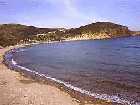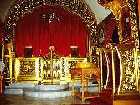Patmos Characteristics




Dramatically beautiful, Patmos is 163 nautical
miles from Piraeus. It's officially the "Holy Island" of the Greek
Government. It is sacred to both Orthodox and Western Christians alike. The island is sometimes called the Jerusalem of the Aegean.
With a large population (2,700) for its size
of 34 sq.km. and 63 km of coast, it is a sophisticated island. Somehow the islanders manage to keep the balance
between religious austerity and having a good time. It's blessed with constant sunshine.
Island Features




The beaches are sandy
and there is a lot to see. Many cruise ships stop there and the main town
of Skala is consequently thriving from the trade. It is touristy. There
are several resort areas, situated on beach fronts in addition to Skala, notably
Lefkes and Grigos. If you're looking for a pious, religious, contemplative
island...sorry! There is nothing undiscovered about Patmos.
Water may be in short supply in summer, although there is a large reservoir behind Skala.
The harbor is particularly beautiful at night with the lights of Chora twinkling above the lights of Skala.
Towns

 Smart, upscale Skala is the island's main resort and anchor. The first thing you see as you enter town is the statue of Protergatis Xanthos Emmanuel, who became famous because he led an uprising against the Turks in 1821.
Smart, upscale Skala is the island's main resort and anchor. The first thing you see as you enter town is the statue of Protergatis Xanthos Emmanuel, who became famous because he led an uprising against the Turks in 1821.
There a red buoy near the beach that is a reminder of the duel of miracles between the evil magician Yenoupas and St John. Yenoupas intended his miracle to be bringing back effigies of the dead from under the sea. St. John, however, prayed that Yenoupas be petrified while he was still submerged. This effectively ended the duel, but the petrified remains of Yenoupas under the harbor still stink of sulphur.

 You can hike up to the site of the ancient city Kastelli in about 20 minutes. There are remains of a Hellenistic wall and the chapel of Ag. Konstantinos. The view is stunning, especially at sunset.
You can hike up to the site of the ancient city Kastelli in about 20 minutes. There are remains of a Hellenistic wall and the chapel of Ag. Konstantinos. The view is stunning, especially at sunset.
From Skala, you can see Chora above. A gem of Byzantine architecture, Chora clings to the walls of the monastery. It is walkable, but buses also make the trip. Chora has a wonderful panoramic view, a maze of alleyways, chapels, and lavish mansions. Many of the buildings have distinctive window moldings decorated with Byzantine crosses.
The Monastery of St John the Theologian (fee, modest dress required) is built behind walls that withstood every invader and marauder for centuries. Inside are narrow corridors, courtyards, chapels, tombs, and the Treasury Museum. The museum has many wonders including gold and silver crosses, superb icons, jeweled pendants from Catherine the Great and many rare manuscripts. Among the manuscripts is St Mark's gospel, written on purple vellum. (You have to get special permission to see it.) Orthodox Easter celebrations at the Monastery of St John bring hundreds of worshippers into Chora. The abbot of the monastery washes the feet of 12 monks to reenact the washing of the disciples feet before the last supper. The washing ceremony is on Maundy Thursday.
In addition to that prime attraction, there are 40 or so other churches in Chora. Especially worth seeing are the Convent of Zoodochos Pigi, Convent of the Evangelismos and the Monastery of the Apocalypse.
On the path between Skala and Chora is the Holy Cave of the Apocalypse. This is where St John saw the vision of fire and brimstone he recorded in the Book of Revelation. You can see the rock where he wrote and the indentation where he rested his head. There's a fissure in the roof, from which the voice of God was said to have come.
Beaches and Villages
The closest beach to Skala is Meloi. It's shaded but tends to get crowded. More peaceful is Agriolivadi, in a rocky cove with a couple of tavernas.
Walkers enjoy the dramatic coast around Ano Kambos, the central village of the island at the end of the bus line. The village is surrounded by fertile fields. There are beaches in every direction.
Roads from Skala and Chora go to the beach resort at Grikou. There's a beautiful bay here and lots of watersport opportunties. At the south end of the bay, Kalikatsou Rock may be the hermitage mentioned in the writings of Christodoulos. Inland at Sykamia is the old Roman bath that St John may have used in baptisms.
The road south ends where Patmos is only a few hundred yards across at the Stavros chapel. There's a beach here. Also nearby is the fine white sandy beach at Psili Ammos. To the west is the hot and smelly seaside grotto at Cape Yenoupas, former home to the evil magician.
Drinking and Dining
In Skala, the eating places center around the harbor. The villages have decent eateries and light snacks. The food here is considered better than average.
History
Patmos is the most sacred of the Greek islands because when
St. John the Divine was exiled there and living in a cave, he wrote the Book
of Revelations. St. John was the beloved apostle of Jesus. He may have only spent a year or so exiled on Patmos, but his gospel was such an accurate prophecy of the fall of the Roman Empire that it's kept people talking for 2000 years.
The island was abandoned in the 7th Century. Much later, the Emperor in Constantinople gave the island to a saintly hermit named Christodoulos.
In the 11th Century, the Blessed Christodoulos formed a fortified monastery in honor of St John, more wealthy and influential than any other in Greece, with the exception of Mount Athos. Constaninople granted the island building funds, tax exemptions and the right to engage in sea trade.
The island was under the control of the monastery for hundreds
of years and received special status even from the Turks. Patmos began to prosper and by 1720, monks and laymen divided the land between them.




